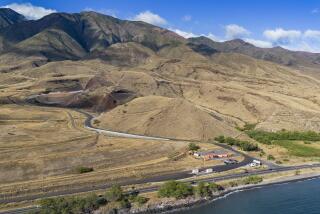County Faces Toxic Waste Site Deadline
San Diego County must decide how and where to locate hazardous waste-treatment facilities before a May, 1990, deadline or face the prospect of forfeiting that authority to the state, a county hazardous materials specialist told a San Diego City Council committee Wednesday.
David Merk, project manager for a county task force now considering hazardous waste siting criteria and locations, told the council’s Public Services and Safety Committee that state legislation signed into law by Gov. Deukmejian on Sept. 10, 1986, requires California counties to develop plans for siting hazardous waste facilities.
If the plan is not drawn up or a municipality turns down a private hazardous waste processor proposal to build a facility that conforms to the plan, the governor’s office can order that city to allow construction of the waste-treatment facility, Merk told the committee.
“What they’re doing is making us face up to a problem, recognize it, and handle it,” said Councilwoman Gloria McColl, the committee’s chairwoman.
“The alternative to this is what I call ‘midnight disposal,’ ” said outgoing Councilman Bill Cleator. “(Hazardous waste producers) get rid of it one way or another. You’re going to find this material in your open space and your backyards and everywhere else.”
Weighing Criteria
Merk’s task force, known officially as the San Diego County Hazardous Waste Management Plan Advisory Committee, is composed of representatives from each city and unincorporated areas, as well as experts from an environmental group, the hazardous waste industry, the U.S. Navy, the San Diego State University Graduate School of Public Health and others.
The group currently is weighing various criteria to impose as restrictions on private firms wishing to establish a waste-processing plant and scanning the county to determine suitable areas for such facilities. For example, the group expects to adopt criteria specifying allowable distances from an earthquake fault, residential areas, and transportation arteries, Merk said.
The county plan, which must be approved by a majority of cities and towns containing a majority of the county’s population, is due by October, 1988. Once the plan is approved, each city retains the responsibility of approving or rejecting private hazardous waste facilities necessary after May, 1990, when it becomes illegal to put untreated hazardous waste in landfills under the terms of the new law.
Waste-treatment processes can range from incineration to neutralizing acids by combining them with bases to form water, Merk said. Much of the county’s waste treatment is currently being done on-site by the companies that produce the hazardous waste, he said.
Controversial Proposal
The new law will have no impact on Ogden Environmental Services Inc.’s controversial proposal to burn toxic wastes in La Jolla because the law exempts treatment facilities used for research and development of new technologies, Merk said.
Merk brought the committee some good news concerning the county’s hazardous waste, 70% of which is generated in the City of San Diego. About 50% to 80% of the 120,000 tons of hazardous waste produced in the county each year already is being handled properly under the rules that will take effect in 1990, he said.
“That’s largely because all of our waste oil is being handled properly,” Merk said. Waste oil and bilge water, primarily from Navy ships, accounts for 51.2% of the county’s hazardous waste. Virtually all of it is being recycled.
Another 15.1% of the county’s waste is the metallic “fluff” produced by automobile shredders, which Merk said probably will continue to be allowed in landfills after 1990.
More to Read
Sign up for Essential California
The most important California stories and recommendations in your inbox every morning.
You may occasionally receive promotional content from the Los Angeles Times.









